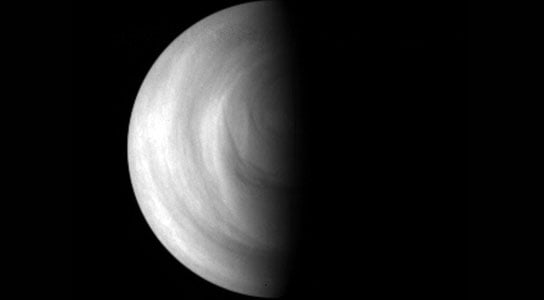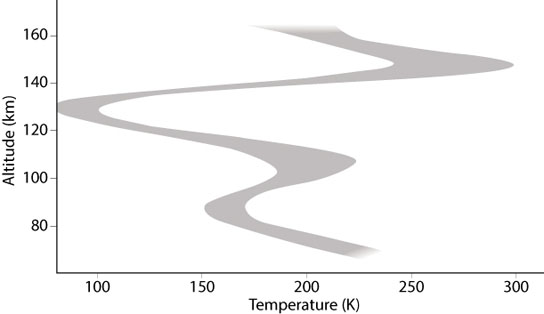
This image of Venus’ southern hemisphere illustrates the terminator – the transitional region between the dayside (left) and nightside of the planet (right). The south pole is near the terminator, just above the center of the image. The complex atmosphere that surrounds the planet is also clearly visible. The image was taken at ultraviolet wavelengths by the Venus Monitoring Camera (VMC) on ESA’s Venus Express spacecraft on May 15, 2006, when the spacecraft was flying at about 66,500 km distance from the planet. Credit: ESA/MPS, Katlenburg-Lindau, Germany
Based on a new analysis of compiled data from ESA’s Venus Express, scientists have uncovered a very chilly layer high in Venus’s atmosphere with temperatures of around –175ºC at 125 km above the planet’s surface. This is colder than any part of Earth’s atmosphere, despite Venus being much closer to the Sun.
Venus Express has spied a surprisingly cold region high in the planet’s atmosphere that may be frigid enough for carbon dioxide to freeze out as ice or snow.
The planet Venus is well known for its thick, carbon dioxide atmosphere and oven-hot surface, and as a result, is often portrayed as Earth’s inhospitable evil twin.
But in a new analysis based on five years of observations using ESA’s Venus Express, scientists have uncovered a very chilly layer at temperatures of around –175ºC (-283ºF) in the atmosphere 125 km (78 mi) above the planet’s surface.
The curious cold layer is far frostier than any part of Earth’s atmosphere, for example, despite Venus being much closer to the Sun.
The discovery was made by watching as light from the Sun filtered through the atmosphere to reveal the concentration of carbon dioxide gas molecules at various altitudes along the terminator – the dividing line between the day and night sides of the planet.
Armed with information about the concentration of carbon dioxide and combined with data on atmospheric pressure at each height, scientists could then calculate the corresponding temperatures.
“Since the temperature at some heights dips below the freezing temperature of carbon dioxide, we suspect that carbon dioxide ice might form there,” says Arnaud Mahieux of the Belgian Institute for Space Aeronomy and lead author of the paper reporting the results in the Journal of Geophysical Research.

The temperature profile along the terminator for altitudes of 70–160 km above the surface of Venus. The values were derived from the volume density of carbon dioxide molecules measured during solar occultation experiments by Venus Express’ SOIR instrument. The graphic provides the average range of values calculated from 59 measurements taken along the terminator from 88ºN to 77ºS, during different orbits between 2006 and 2011. The new report finds a prominent cold layer at 125 km sandwiched between two comparatively warmer layers at around 100 km and 140 km. At some locations, the temperatures occasionally dip below the freezing temperature of carbon dioxide, which suggests that carbon dioxide ice or snow could exist at these altitudes. Credit: ESA/AOES
Clouds of small carbon dioxide ice or snow particles should be very reflective, perhaps leading to brighter than normal sunlight layers in the atmosphere.
“However, although Venus Express indeed occasionally observes very bright regions in the Venusian atmosphere that could be explained by ice, they could also be caused by other atmospheric disturbances, so we need to be cautious,” says Dr. Mahieux.
The study also found that the cold layer at the terminator is sandwiched between two comparatively warmer layers.
“The temperature profiles on the hot dayside and cool night side at altitudes above 120 km (75 mi) are extremely different, so at the terminator, we are in a regime of transition with effects coming from both sides.
“The night side may be playing a greater role at one given altitude and the dayside might be playing a larger role at other altitudes.”
Similar temperature profiles along the terminator have been derived from other Venus Express datasets, including measurements taken during the transit of Venus earlier this year.
Models are able to predict the observed profiles, but further confirmation will be provided by examining the role played by other atmospheric species, such as carbon monoxide, nitrogen, and oxygen, which are more dominant than carbon dioxide at high altitudes.
“The finding is very new and we still need to think about and understand what the implications will be,” says Håkan Svedhem, ESA’s Venus Express project scientist.
“But it is special, as we do not see a similar temperature profile along the terminator in the atmospheres of Earth or Mars, which have different chemical compositions and temperature conditions.”
Reference: “Densities and temperatures in the Venus mesosphere and lower thermosphere retrieved from SOIR on board Venus Express: Carbon dioxide measurements at the Venus terminator” by A. Mahieux, A. C. Vandaele, S. Robert, V. Wilquet, R. Drummond, F. Montmessin and J. L. Bertaux, 3 July 2012, Journal of Geophysical Research: Planets.
DOI: 10.1029/2010JE003589









Venus is a cloud clothed planet unlike mercury which is naked one. Even Mars is not so much cloud capped but it can show some of its features like ridges and canyons. In venus you cannot have a glimpse of its surface from any earth based telescopes. Now with regard to temperature we know that it is function of altitude only. In a very hot summer also the great Himalayas which is about five miles high only produces adequate ice caps to produce perennial rivers Ganges, Indus and Brahmaputra in all seasons. This example is given only to prove that at 125 kms above Venusian surface, it is natural that very chilly weather at about -175 degrees celcius. Atmospherics simply obeys physics laws. Theoretically even on a hot land a pole of 5 kms high if erected theoretically, it will produce water capping of clouds. Moreover venus is partially gravitationally locked to Sun, whereas Mercury is over locked to produce retrogade spinning. Temperature at high altitude si something different from temperature on land. Thank You.